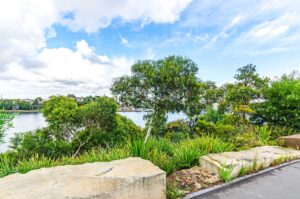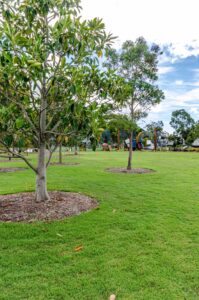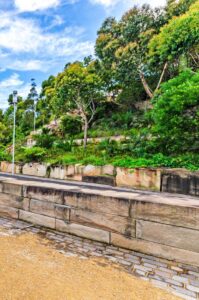
Harbourside haven
By Lynne Testoni
A careful and considered planting schedule is the key to the continued maintenance of a high-profile public parkland.
There is a lot of pressure for any company tackling a high-profile public project, but Landscape Solutions (landscapesolutions.com.au) rose to the occasion with the maintenance of this award-winning parkland for Barangaroo Point Reserve.
Landscape Solutions won a Gold Medal for the Barangaroo Reserve project in the 2022 Landscape Excellence Awards in the Maintenance Commercial – Parklands / Open Spaces category, maintaining a space that encompasses thoughtful native plantings and public open space.
Landscape architect on the project, Stuart Pittendrigh, specified an informal look across the site, including hard surfaces. All entries, pathways, and staircases needed to be available for public use.
In addition, the use of glyphosate is prohibited throughout the reserve, so only hand weeding is allowed.
The brief
The brief included a distinct planting strategy:
- A bush planting from top to bottom on the western and southern slopes and aspects
- A series of tree plantings in more open areas, using the tallest of the bush species, but abstracted from the bush

- Large specimen trees forming transitions from adjacent neighbourhoods, and dotting the more open grass areas on the top and northern side of the headland.
Most of the plantings were native to Sydney Harbour, except for the turf and just five of the 83 plant species used.
Specially manufactured soils maximise the growth of the plantings. The soil specification utilises crushed and washed recycled materials along with compost additions, which provide for optimum growth and health of the selected plants.
Bush planting
The bush is the most complex planting in the reserve. It consists of three separate layers: ground plane, understory planting, and canopy.
The ground plane of plants is from approximately 0.5m to 2m in depth, including plants and vines to initially cover the low walls. Plants included Lomandra longifolia (mat rush) and Hardenbergia violacea (native sarsaparilla).
An understory of plants up to about five metres in height gives the headland the distinctive shape of existing Sydney headlands, such as Acacia longifolia (Sydney golden wattle).
The canopy of trees ranges from 10m to 20m in height, forming a series of cathedral-like spaces within the bush layers. Plantings include Angophora costata (smooth bark apple), Eucalyptus pilularis (blackbutt), and Eucalyptus saligna (Sydney blue gum).
The newly created bush will require special management to allow it to grow and be protected so that it can achieve maturity.
Maintenance of the parklands
Mulching is done during July and August, and the soil beneath all trees, shrubs, and groundcover is kept covered with mulch. A minimum of a 50mm layer of mulch is maintained to help eliminate and suppress weed growth, conserve soil moisture, and reduce the need for watering. Stone mulch was installed in areas prone to persistent strong winds.

Weekly soil management includes checking the soil moisture levels by hand every three days to determine moisture levels in the various planting precincts. Irrigation drip lines and spray heads are randomly checked on an ongoing basis so that the entire irrigation system is checked each week.
The lawn management program is designed to maximise plant health, deepen grass roots, and to apply water and fertiliser to maximise their use efficiently and effectively. Mowing cycles are performed weekly during the prime growing seasons and twice monthly from autumn to early spring. Lawn fertiliser is applied each March and October.
About the awards
This garden was a gold winner of the Maintenance – Commercial Parklands / Open Spaces category at the 2022 Landscape Excellence Awards, which celebrate the very highest standards and achievement in Landscape Construction, Design, and Maintenance, in the Residential and Commercial sectors. To learn about the 2023 Landscape Excellence Awards, proudly brought to you by GlazedCo, and how to enter, visit www.landscapeassociation.com.au.
Trade show
The Landscape Association (TLA) will be launching the inaugural TLA Landscape Expo, hosted by TAFE NSW at their Ryde Campus on Wednesday 6 September 2023. This trade-focused event will be packed with product information and demonstrations, professional speakers, and trade exhibitors, and is open to TLA members and the broader landscaping industry. For more information on how to get involved as an exhibitor, sponsor, or attendee, head to The Landscape Association’s website: https://www.landscapeassociation.com.au/
Main photo: Angophora costata, Sydney Red Gum, was added to the lawn and sloped areas of the reserve to provide additional shade and protection (Image: The Landscape Association)
